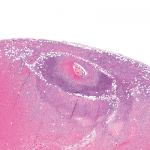 Although rheumatologists do not know the cause of giant cell arteritis (GCA), researchers have identified many of its risk factors. These factors have largely been determined based on cohorts of patients of Northern European descent that include information about age, sex and HLA DRB1. These past studies have also suggested GCA is uncommon in black patients.
Although rheumatologists do not know the cause of giant cell arteritis (GCA), researchers have identified many of its risk factors. These factors have largely been determined based on cohorts of patients of Northern European descent that include information about age, sex and HLA DRB1. These past studies have also suggested GCA is uncommon in black patients.
New Findings
Although biopsy-proven GCA occurs more commonly in women, recent research indicates its rates are similar between races. The research by Anna M. Gruener, BMBS, an ophthalmologist from Nottingham University Hospitals National Health Service Trust, U.K., and colleagues suggests GCA does not occur more frequently in white patients than in black patients. The investigators published their findings online Aug. 8 in JAMA Ophthalmology. The retrospective cohort study compared the incidence of biopsy proven GCA in black patients with white patients.1
“In our 10-year retrospective study of GCA at the Johns Hopkins Wilmer Eye Institute, we reviewed the medical records of 586 patients who had [temporal artery biopsies], 93 of whom had positive findings,” write the authors in their discussion. “To our knowledge, the only other North American study of GCA incidence with a comparable sample size to ours evaluated patients from Olmsted County, Minn., where the population is predominantly white. That study identified 173 incident cases of GCA during a 50-year study period. Our study is the largest, to our knowledge, to examine GCA incidence in a population that includes a sizeable proportion of black patients.”
The researchers calculated an overall age- and sex-adjusted incidence rate of biopsy-proven GCA of 3.5 (95% confidence interval [CI], 2.5–4.5) per 100,000 population per year.
The Patients
The investigators evaluated patients seen at the Johns Hopkins Wilmer Eye Institute, Baltimore. Patients were selected for temporal artery biopsies based on their clinical presentation. Although the population in the current study differed from previous studies with regards to ethnicity, it was similar to previous studies in terms of mean age (70.5 years) and sex ratios (72.2% women). The mean age of patients selected for temporal artery biopsy was higher in 31 white patients than black patients, mean difference of 2.7 years (95% CI, 0.6–4.7 years; P=0.01).
The researchers classified patients with biopsies of healed arteritis as having biopsy-proven GCA. For this classification, the healing could be a significant fragmentation and/or loss of internal elastic lamina with associated thinning and fibrosis or scarring of the media, sometimes with capillary neovascularization. The researchers classified indeterminate findings of biopsies as negative.


